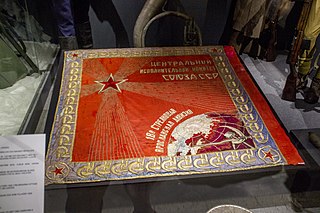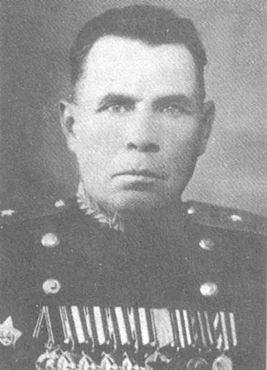The Southwestern Front was a front of the Red Army during the Second World War, formed thrice.
The Reserve Front was a major formation of the Red Army during the Second World War.

Nikolai Erastovich Berzarin was a Red Army colonel general who held field army commands during World War II. A Hero of the Soviet Union, in 1945 he became the first commandant of the Soviet occupying forces in Berlin.
A mechanised corps was a Soviet armoured formation used prior to the beginning of World War II and reintroduced during the war, in 1942.
The 110th Rifle Division was a formation of the Soviet Union's Red Army during the course of World War II, which was formed, dissolved, and re-formed three times throughout the war.
The 62nd Army was a field army established by the Soviet Union's Red Army during the Second World War.
The 22nd Army was a field army of the Red Army during World War II.
The 30th Army was a Soviet field army of the Red Army active between 1941 and 1943. It was re-organised to the 10th Guards Army on 16 April 1943.
The 27th Army was a field army of the Soviet Union's Red Army, which fought in World War II.
The 39th Army was a Field Army of the Soviet Union's Red Army during World War II and of the Soviet Army during the Cold War.

The 18th Rifle Division was an infantry division of the Soviet Union's Red Army during the Russian Civil War, Polish–Soviet War, Winter War and World War II. The division was formed a total of five times during this period.
The 31st Army was a field army of the Red Army during the Second World War.
The 43rd Army was a Red Army field army of World War II that served on the Eastern Front. Formed in late July 1941, the army fought in the Battle of Smolensk (1941). It was forced to retreat after German troops broke through in October 1941 and subsequently fought in the Battle of Moscow. The army then fought in the Rzhev-Vyazma Offensive. After the end of the offensive, the army held its positions and transferred to the Demidov area in late 1942. It fought in the Battle of Smolensk (1943). During the summer of 1944, the army fought in Operation Bagration. In the fall the army advanced into the Baltic region and fought in the Riga Offensive (1944) and the Battle of Memel. In 1945 the army fought in the East Prussian Offensive before being placed in reserve near the end of April. The 43rd Army was disbanded postwar in July 1946.

The 5th Shock Army was a Red Army field army of World War II. The army was formed on 9 December 1942 by redesignating the 10th Reserve Army. The army was formed two times prior to this with neither formation lasting more than a month before being redesignated.
The 34th Army was part of the Red Army during the Second World War. The army was formed on 16 July 1941 in the Moscow Military District.
The 220th Rifle Division was briefly a Red Army motorized infantry division that was re-organised shortly after the German invasion as a standard rifle division.

The 251st Rifle Division was the seventh of a group of 10 regular rifle divisions formed from cadres of NKVD border and internal troops as standard Red Army rifle divisions, very shortly after the German invasion, in the Moscow Military District. It was largely based on what would become the shtat of July 29, 1941, with several variations. It served under command of 30th Army in an effort to recover Smolensk in late July and in the Dukhovshchina offensives in August and September, and was quickly reduced to a much-weakened state. It was largely encircled in the initial stages of Operation Typhoon but sufficient men and equipment escaped that it was spared being disbanded. In the following two and a half years the division slogged through the difficult and costly battles around Rzhev and Smolensk as part of 20th Army, and later 31st Army, of Western Front, including several abortive offensives toward Orsha and Vitebsk in late 1943 and early 1944. At the start of Operation Bagration in June the 251st was serving in the 39th Army of 1st Baltic Front and it won a battle honor for its part in the liberation of Vitebsk. Following this victory it advanced into the "Baltic Gap" that had formed between Army Groups North and Center, entering Lithuania and winning the Order of the Red Banner for its part in the fighting for Kaunas. The division was transferred to 43rd Army and then 4th Shock Army as the Front advanced on Riga, and two of its rifle regiments received decorations for the battles for the Latvian capital. In the first days of 1945 the 251st was reassigned yet again, to the 2nd Guards Army of 3rd Belorussian Front, and served under this Army for the duration of the war. It, and several of its subunits, received awards during the East Prussian campaign, and ended the war in East Prussia. After the war the 251st was moved into the Caucasus region, and was finally disbanded in early 1947.

The 252nd Rifle Division was the eighth of a group of 10 regular rifle divisions formed from cadres of NKVD border and internal troops as standard Red Army rifle divisions, very shortly after the German invasion, in the Moscow Military District.
The 50th Army was a Soviet field army during World War II. It was formed in mid-August, 1941 and deployed on the southwest approaches to Moscow. Partly encircled and destroyed by German Second Panzer Army in the opening stages of Operation Typhoon, enough of the army escaped that it could be reinforced to successfully defend the city of Tula in November. It was at this time that the 50th came under the command of Lt. Gen. Ivan Boldin, who continued in command until February, 1945. During most of its career the army was relatively small and accordingly served in secondary roles. It finished the war in East Prussia, under the command of Lt. Gen. Fyodor Ozerov, as part of 3rd Belorussian Front.
The 178th Rifle Division was formed as an infantry division of the Red Army in the Siberian Military District, based on the shtat of September 13, 1939, on the basis of the separate 386th Rifle Regiment. Following the German invasion it was moved west and concentrated west of Moscow as part of 24th Army in early July. Late that month the Army was assigned to Reserve Front. While this Army played the main role in the successful offensive at Yelnya, the 178th was held in reserve. In late August, in response to a German drive against 22nd Army on the right flank of Western Front, the division was moved by rail and truck northward to join 29th Army in the vicinity of Nelidovo, to cover the gap between that Army and the 22nd. When Army Group Center launched Operation Typhoon in early October the 29th Army was not directly affected, but soon had to fall back to the northeast under pressure from German 9th Army, giving up the town of Rzhev in the process. On October 17 the 29th Army became part of the new Kalinin Front, and later in the month the 178th was moved to 22nd Army. On January 15, 1942, the Army went over to the counteroffensive, and the 178th soon found itself fighting to regain territory around Rzhev that it had been forced from months before. In February, the division was reassigned to 30th Army, and it remained in that Army through the summer battles for the Rzhev salient. During Operation Mars, in November, it was in 39th Army, and managed to gain ground during this otherwise failed offensive. During March 1943 the 178th took part in the pursuit of the German forces evacuating the salient, but soon came up on the extensive fortifications that had been built at its base, and remained facing them into August. When offensive fighting resumed the Army's objective was the town of Dukhovshchina, but it was only taken after heavy combat well into September. Once the town was taken the division was awarded a battle honor. Shortly after it was reassigned to 3rd Shock Army, still in Kalinin Front. During the fall and winter campaign of 1943/44 it faced the heavily fortified German positions just east of Novosokolniki as part of 2nd Baltic Front's 11th Guards and 22nd Armies, and finally liberated that town in late January 1944, earning the Order of the Red Banner. It left the fighting front in late March for a period of rebuilding in the Reserve of the Supreme High Command; when it returned in May it was assigned to 21st Army in Leningrad Front.





